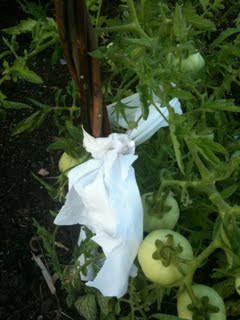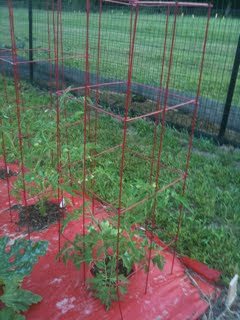With this week's summer solstice just past, welcome to official inaugural tomato season at the Chatham Community Garden. The tomato (Lycopersicon esculentum -- which translates to juicy wolf peach!) is a member of the Nightshade family. Most heirloom tomatoes and many modern varieties are indeterminate, the technical term for a vining, ever-bearing habit. 'Big Boy,' 'Early Girl,' 'Brandywine' and most cherry tomatoes are indeterminate.
If you plant any varieties labeled "dwarf" or "bush" or "compact," it is probably determinate, meaning the fruit sets and ripens all at once. 'Rutgers' and 'Roma' are two examples of determinate varieties.
Farmer Paul suggested that I post about staking tomatoes.
Some people let their tomatoes vine along the ground, but I don't recommend it. The fruit tends to get eaten by critters or quickly rot where it contacts the soil. Plus in our little 10'X10' beds, they will take over!
Down at the garden tonight, I noticed many different staking strategies. It will be interesting to compare them as the season progresses.
There are sturdy metal and string trellises.
Old sheets make very soft ties that won't saw into the plants.
Wow! Red cages with matching mulch. With cages you need to push the young branches inside when they try to escape.
You can also combine wire cages and stakes.
I like these plastic rods. They remind me of Tinker Toys.
Regular wooden stakes work really well. Just keep up with the tying. With indeterminate tomatoes you can also manage the size by pruning out the suckers (new side shoots). If you do it in the morning when they have hydrated, you can just snap them off with your fingers. This is especially important if you stake with those cool spiral stakes.
With visions of ripe tomatoes dancing in our heads.
Thursday, June 24, 2010
Subscribe to:
Posts (Atom)








